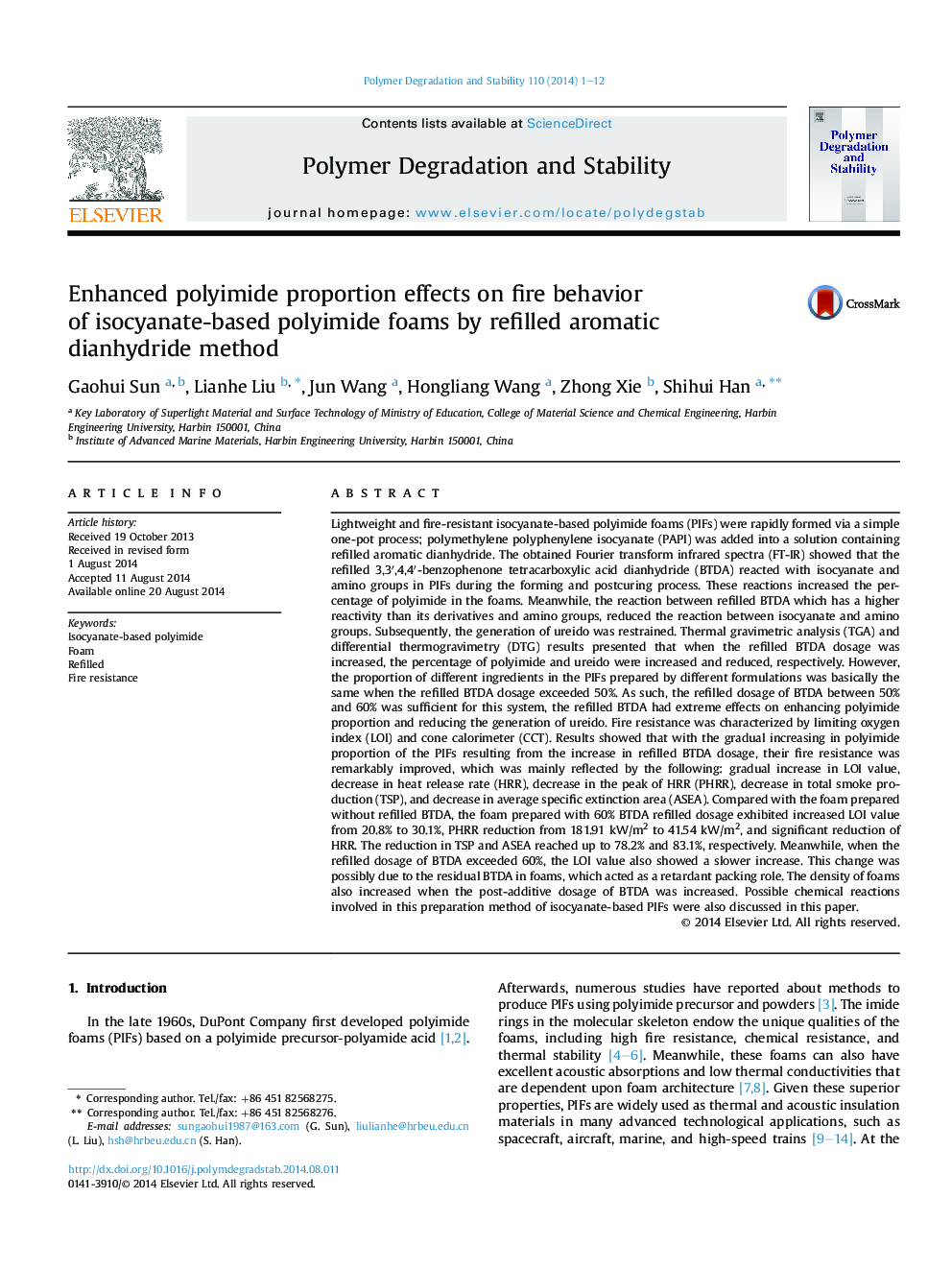| کد مقاله | کد نشریه | سال انتشار | مقاله انگلیسی | نسخه تمام متن |
|---|---|---|---|---|
| 5201629 | 1502903 | 2014 | 12 صفحه PDF | دانلود رایگان |
عنوان انگلیسی مقاله ISI
Enhanced polyimide proportion effects on fire behavior of isocyanate-based polyimide foams by refilled aromatic dianhydride method
ترجمه فارسی عنوان
اثرات متقابل پلی امید نسبت به رفتار آتش نشانی فوم پلی امید مبتنی بر ایزوسیانات با استفاده از روش دیان هیدرید معطر
دانلود مقاله + سفارش ترجمه
دانلود مقاله ISI انگلیسی
رایگان برای ایرانیان
کلمات کلیدی
پلی آمید مستقر در ایزوسیانات، فوم دوباره پر کردن مقاوم در برابر آتش،
موضوعات مرتبط
مهندسی و علوم پایه
شیمی
شیمی آلی
چکیده انگلیسی
Lightweight and fire-resistant isocyanate-based polyimide foams (PIFs) were rapidly formed via a simple one-pot process; polymethylene polyphenylene isocyanate (PAPI) was added into a solution containing refilled aromatic dianhydride. The obtained Fourier transform infrared spectra (FT-IR) showed that the refilled 3,3â²,4,4â²-benzophenone tetracarboxylic acid dianhydride (BTDA) reacted with isocyanate and amino groups in PIFs during the forming and postcuring process. These reactions increased the percentage of polyimide in the foams. Meanwhile, the reaction between refilled BTDA which has a higher reactivity than its derivatives and amino groups, reduced the reaction between isocyanate and amino groups. Subsequently, the generation of ureido was restrained. Thermal gravimetric analysis (TGA) and differential thermogravimetry (DTG) results presented that when the refilled BTDA dosage was increased, the percentage of polyimide and ureido were increased and reduced, respectively. However, the proportion of different ingredients in the PIFs prepared by different formulations was basically the same when the refilled BTDA dosage exceeded 50%. As such, the refilled dosage of BTDA between 50% and 60% was sufficient for this system, the refilled BTDA had extreme effects on enhancing polyimide proportion and reducing the generation of ureido. Fire resistance was characterized by limiting oxygen index (LOI) and cone calorimeter (CCT). Results showed that with the gradual increasing in polyimide proportion of the PIFs resulting from the increase in refilled BTDA dosage, their fire resistance was remarkably improved, which was mainly reflected by the following: gradual increase in LOI value, decrease in heat release rate (HRR), decrease in the peak of HRR (PHRR), decrease in total smoke production (TSP), and decrease in average specific extinction area (ASEA). Compared with the foam prepared without refilled BTDA, the foam prepared with 60% BTDA refilled dosage exhibited increased LOI value from 20.8% to 30.1%, PHRR reduction from 181.91Â kW/m2 to 41.54Â kW/m2, and significant reduction of HRR. The reduction in TSP and ASEA reached up to 78.2% and 83.1%, respectively. Meanwhile, when the refilled dosage of BTDA exceeded 60%, the LOI value also showed a slower increase. This change was possibly due to the residual BTDA in foams, which acted as a retardant packing role. The density of foams also increased when the post-additive dosage of BTDA was increased. Possible chemical reactions involved in this preparation method of isocyanate-based PIFs were also discussed in this paper.
ناشر
Database: Elsevier - ScienceDirect (ساینس دایرکت)
Journal: Polymer Degradation and Stability - Volume 110, December 2014, Pages 1-12
Journal: Polymer Degradation and Stability - Volume 110, December 2014, Pages 1-12
نویسندگان
Gaohui Sun, Lianhe Liu, Jun Wang, Hongliang Wang, Zhong Xie, Shihui Han,
